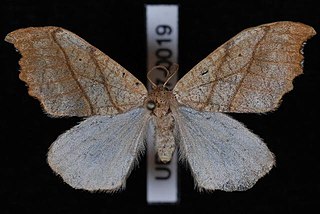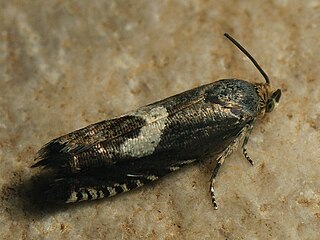
Eudonia mercurella is a species of moth of the family Crambidae. It is found in Europe, western China, Iran, Lebanon, Turkey, and north-western Africa.

Boloria chariclea, the Arctic fritillary or purplish fritillary, is a butterfly of the family Nymphalidae. It is found in the northern parts of the Palearctic and Nearctic realms.

Blastesthia is a genus of moths belonging to the subfamily Olethreutinae of the family Tortricidae.

Metendothenia is a genus of moths belonging to the subfamily Olethreutinae of the family Tortricidae.

Cydia duplicana is a small moth of the family Tortricidae. It is found in all across Europe, extending barely into Asia in the Transcaucasus, Turkestan and Kazakhstan.

Phyllonorycter hilarella is a moth of the family Gracillariidae. It is found in all of Europe, except the Balkan Peninsula and the Mediterranean Islands.

Pediasia truncatellus is a species of moth in the family Crambidae described by Johan Wilhelm Zetterstedt in 1839. It is found in Fennoscandia, northern Russia, the Baltic region, the Czech Republic and Canada.
Loxostege ephippialis is a species of moth in the family Crambidae. It was described by Johan Wilhelm Zetterstedt in 1839. It is found in Norway, Sweden, Finland, Russia and North America.

Elophila tinealis, the black duckweed moth, is a moth in the family Crambidae. It was described by Eugene G. Munroe in 1972. It is found in North America, where it has been recorded from Michigan, Ontario and New York, south to Florida and west to Texas. The habitat consists of swamps and wet woods.

Petrophila canadensis, the Canadian petrophila moth, is a moth in the family Crambidae. It was described by Eugene G. Munroe in 1972. It is found in North America, where it has been recorded from southern Canada and the north-eastern United States.

Falcaria bilineata, the two-lined hooktip moth, is a moth in the family Drepanidae. It was described by Packard in 1864. It is found in North America, where it has been recorded from Newfoundland to New Jersey, west to Oregon and north to British Columbia. The habitat consists of deciduous woodlands.

Apotomis turbidana is a moth belonging to the family Tortricidae. The species was first described by Jacob Hübner in 1825.

Rhopobota stagnana is a moth belonging to the family Tortricidae. The species was first described by Michael Denis and Ignaz Schiffermüller in 1775.

Grapholita lunulana is a moth belonging to the family Tortricidae. The species was first described by Michael Denis and Ignaz Schiffermüller in 1775.

Grapholita orobana is a moth belonging to the family Tortricidae. The species was first described by Georg Friedrich Treitschke in 1830.It is native to the Palearctic.

Lobesia fuligana is a moth belonging to the family Tortricidae. The species was first described by Adrian Hardy Haworth in 1811. It is found in Europe.
Phiaris obsoletana is a species of moth belonging to the family Tortricidae.

Cydia coniferana is a Palearctic moth belonging to the family Tortricidae. The species was first described by Saxesen in 1840. The wingspan is 11-13 mm. The forewings are dark fuscous, the costa posteriorly with white strigulae, some ending in obscure leaden-metallic marks. There is an irregular erect white dorsal median spot, including a dark fuscous strigula. The ocellus is edged with leaden-metallic, and crossed by several black dashes. The hindwings are fuscous. The larva is dull yellowish ; head pale brown

Dichrorampha consortana is a moth belonging to the family Tortricidae. The species was first described by James Francis Stephens in 1852.

















